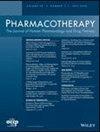老年痴呆症患者的谵妄事件及相关治疗调整:医疗保险数据的间断时间序列分析
IF 2.9
3区 医学
Q2 PHARMACOLOGY & PHARMACY
引用次数: 0
摘要
背景阿尔茨海默病(AD)和致谵妄药物都会增加老年人谵妄的风险。本研究探讨了谵妄与患有阿尔茨海默病的老年人在谵妄后 1 年内每月使用抗胆碱能药物、镇静剂和阿片类药物之间的关系。方法这项比较性间断时间序列分析涉及诊断为阿尔茨海默病的成年人(65 岁及以上),他们开始服用胆碱酯酶抑制剂(Cholinesterase inhibitors,ChEIs),该分析基于 2013-2017 年的医疗保险数据。每种结果均采用独立的患者水平分段回归模型,以评估谵妄/指数事件发生后,发生谵妄事件的患者和未发生谵妄的患者(对照组)在 12 个月基线和随访期间的累积抗胆碱能药物负荷 (CAB)、镇静剂负荷和阿片类药物负荷的变化。研究采用了基于倾向评分的稳定加权法来平衡谵妄组和对照组的基线因素。与对照组相比,谵妄事件发生后每月 CAB 立即下降(平均估计值-0.86,P 值:0.01)。谵妄事件发生后,镇静剂用量也出现了类似的下降(-0.06,p 值:0.002)。然而,阿片类药物的用量并没有下降(-0.50,p 值:0.18)。从长期来看,与无谵妄组相比,谵妄组在谵妄后 1 年内的 CAB(0.13;p 值:<0.0001)、镇静剂负荷(0.01;p 值:<0.001)和阿片类药物负荷(0.07;p 值:0.006)均有所增加。结论本研究发现,尽管谵妄事件发生后 CAB 和镇静剂的用量有一定程度的变化,但患有 AD 的老年人在随访 1 年期间的谵妄致病药物负担呈上升趋势。本文章由计算机程序翻译,如有差异,请以英文原文为准。
Delirium event and associated treatment modifications among older adults with Alzheimer's disease: An interrupted time‐series analysis of Medicare data
BackgroundBoth Alzheimer's disease (AD) and deliriogenic medications increase the risk of delirium in older adults. This study examined the association between delirium and the subsequent monthly use of anticholinergic, sedative, and opioid medications in the 1 year after delirium in older adults with AD.MethodsThis comparative interrupted time series analysis involved adults (aged 65 years and older) with a diagnosis of AD initiating on cholinesterase inhibitors (ChEIs) based on 2013–2017 Medicare data. Separate patient‐level segmented regression models were used for each outcome to evaluate changes in the cumulative anticholinergic burden (CAB), sedative load, and opioid load after the delirium/index event using a 12‐month baseline and follow‐up period among patients who had a delirium event and those without delirium (control group). Propensity score‐based stabilized weights were utilized to balance baseline factors in the delirium and control groups.ResultsThe study included 80,019 older adults with AD with incident ChEI use; 17.11% had delirium. There was an immediate decline in monthly CAB after the delirium event (mean estimate −0.86, p ‐value: 0.01) compared to the control group. A similar decline was observed when examining the sedative load (−0.06, p ‐value: 0.002) after the delirium event. However, there was no decline in opioid load (−0.50, p ‐value: 0.18). In the long term, CAB (0.13; p ‐value: <0.0001), sedative load (0.01; p ‐value: <0.001), and opioid load (0.07; p ‐value: 0.006) increased over the 1‐year post‐delirium period in the delirium group compared to those without delirium.ConclusionThis study found the burden of deliriogenic medications over the 1‐year follow‐up showed increasing trends in older adults with AD, even though there was some level shift in CAB and sedative load after the delirium event.
求助全文
通过发布文献求助,成功后即可免费获取论文全文。
去求助
来源期刊

Pharmacotherapy
医学-药学
CiteScore
7.80
自引率
2.40%
发文量
93
审稿时长
4-8 weeks
期刊介绍:
Pharmacotherapy is devoted to publication of original research articles on all aspects of human pharmacology and review articles on drugs and drug therapy. The Editors and Editorial Board invite original research reports on pharmacokinetic, bioavailability, and drug interaction studies, clinical trials, investigations of specific pharmacological properties of drugs, and related topics.
 求助内容:
求助内容: 应助结果提醒方式:
应助结果提醒方式:


